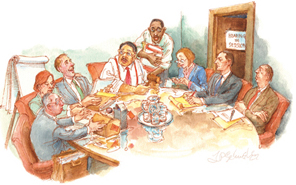Goals Don't Change, But Techniques Should During a Bench Trial

Illustration by John Schmelzer
The bar association’s latest evening program with Angus and Judge Horatio Standwell was about bench trials. I was afraid the topic wouldn’t draw very well, but when Angus offered to pay 2-to-1 on a bet that it would fill the room, I backed down.
Angus was right. Whether you’ve got a pretrial motion, a hearing on an injunction or a full bench trial, you’re in one of those situations where the judge is the jury for all or part of the case. So the bar association didn’t just fill the auditorium; it had to use closed-circuit TV for two adjacent rooms as well.
Five minutes before the program started, law professor Vince Warbler was in the auditorium, trying to sell copies of his book Killer Kross, saying it had several valuable techniques for bench trials.
At 7:30 sharp, Judge Standwell said, “Angus, what’s the worst mistake a lawyer can make in a bench trial?”
Angus paused just a moment, then smiled and said, “It’s something that’s done by one side or the other—often both—in 80 to 90 percent of all kinds of bench trials. The general practice is to submit written statements of the facts you expect to prove well in advance of the trial or hearing. These are not the pleadings. Those were served long ago. The statement of facts is your chance to tell the story of the case to the judge who’s going to try it.
“And the mistake most lawyers make is to write dry statements of facts that may be legally sufficient, but that read like they were written by a committee of law professors who were hunched over piles of dusty law books.”
I looked toward the back and saw Professor Warbler scowling.
Click the link to continue reading “When the Judge Is the Jury: Your goals don’t change in a bench trial, but your techniques should” in the August issue of the ABA Journal online.



